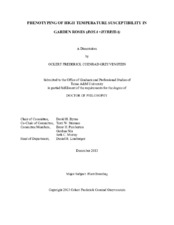| dc.contributor.advisor | Byrne, David H | |
| dc.contributor.advisor | Starman, Terri W | |
| dc.creator | Greyvenstein, Ockert Frederick | |
| dc.date.accessioned | 2014-05-13T17:25:34Z | |
| dc.date.available | 2015-12-01T06:31:16Z | |
| dc.date.created | 2013-12 | |
| dc.date.issued | 2013-12-10 | |
| dc.date.submitted | December 2013 | |
| dc.identifier.uri | https://hdl.handle.net/1969.1/151819 | |
| dc.description.abstract | Roses (Rosa ×hybrida) have delighted man for nearly 5000 years as ornamentals, food, and medicine. A decline in garden roses in the U.S. has been observed in the past 30 years, which can be attributed in part to the lack of widely adapted cultivars. Adaptation to high temperature stress is viewed as high priority in breeding programs of all major crops. High temperature stress negatively affects garden rose performance and the quality of flowers produced. The work described in this dissertation is focused on quantifying high temperature susceptibility in garden roses to enable breeders selecting for high temperature performance to make better selections. Seasonal change in flower size and plant architecture was investigated on 14 field grown cultivars. Controlled environment experiments were used to establish the developmental stage where flowers were most sensitive to high temperatures. The effectiveness of detached leaf assays as indicators of thermotolerance by way of cell membrane thermostablity (MTS) and chlorophyll fluorescence is reported on. Flower abscission and leaf necrosis of whole plants shocked in a heat chamber were correlated to summer flower productivity. The mean daily maximum temperature for days 8 - 14 (2WkMaxºC) before a flower opens best described the fluctuation in flower dry weight during the growing season. Differences in the rate of change were found among cultivars. Subjecting plants at different stages of development to two week high temperature (36/28 ºC) treatments revealed flowers were most sensitive to high temperatures at the visible bud stage of development. Two week high temperature treatments and high temperature shock (44 ºC, 3 h) both resulted in decreased flower dry weight and increased flower abscission. Initial results favored MTS over chlorophyll fluorescence as indicator of high temperature susceptibility. Further investigation showed no correlation between MTS and summer flower intensity recorded for 18 cultivars. Propensity towards flower abscission and leaf necrosis after a three hour heat shock was negatively correlated (r = - 0.55* and r = -0.64**) with field ratings of summer flower intensity. Selecting against the propensity towards flower abscission and leaf necrosis under heat stress is suggested as phenotyping tools to select against high temperature susceptibility prior to field establishment of roses. | en |
| dc.format.mimetype | application/pdf | |
| dc.language.iso | en | |
| dc.subject | heat tolerance | en |
| dc.subject | rose breeding | en |
| dc.subject | rose genetics | en |
| dc.subject | flower size | en |
| dc.subject | flower abscission | en |
| dc.subject | leaf necrosis | en |
| dc.subject | electrolyte leakage | en |
| dc.subject | chlorophyll fluorescence | en |
| dc.subject | cell membrane thermostability | en |
| dc.subject | heat chamber | en |
| dc.title | Phenotyping of High Temperature Susceptibility in Garden Roses (Rosa xhybrida) | en |
| dc.type | Thesis | en |
| thesis.degree.department | Horticultural Sciences | en |
| thesis.degree.discipline | Plant Breeding | en |
| thesis.degree.grantor | Texas A & M University | en |
| thesis.degree.name | Doctor of Philosophy | en |
| thesis.degree.level | Doctoral | en |
| dc.contributor.committeeMember | Pemberton, Brent H | |
| dc.contributor.committeeMember | Niu, Genhua | |
| dc.contributor.committeeMember | Murray, Seth C | |
| dc.type.material | text | en |
| dc.date.updated | 2014-05-13T17:25:34Z | |
| local.embargo.terms | 2015-12-01 | |


